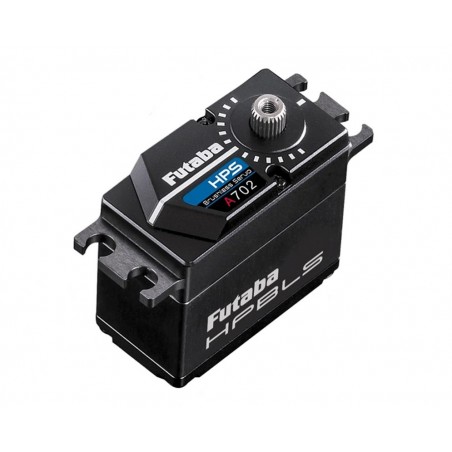


Product on order - waiting time about 7 days.
A monstrously powerful and fast programmable standard S.BUS2/S.BUS digital servo with an AC motor, steel gears and an output shaft mounted in ball bearings with an increased power supply voltage. To ensure excellent cooling and high mechanical resistance, the servo is housed in an all-metal housing. It is particularly ideal for giant class aircraft models and other high thrust applications.
The HPS-A702 can be connected to the outputs of S.BUS 2 (serial bus with two-way communication) or S.BUS (serial bus with one-way communication) receivers, or it can operate as a classic servo connected to the channel (PWM) output of the receiver.
Using CIU-3 USB interface and S-Link PC software or Futaba transmitter equipped with S.BUS servo setting function, you can program a whole range of servo parameters (speed, deviation size, neutral position, overload protection , soft start, etc.). Setting the channel for S.BUS2/S.BUS operation is only possible with the transmitter.
Increased supply voltage of 6.0-7.4 V. Requires a power battery with high current capacity, do not use UBEC stabilizers.
What is S.BUS2/S.BUS
S.BUS - Futaba's serial bus with one-way communication to control servos, controllers, switches, gyros and other compatible RC devices connected to a single output port of the S.BUS receiver.
S.BUS2 - Futaba serial bus for bidirectional communication enabling (as S.BUS) control of servos, controllers, switches, gyroscopes and other compatible RC devices connected to one
s.BUS2 output/input port of the receiver. In addition, it allows the connection of telemetry sensors and the transmission of data from them through the receiver for display on the transmitter; from some servos, the S.BUS2 can transmit to the transmitter information about the operating current, temperature or output angle of the servo.
Unlike classic RC kits, the S.BUS(2) system uses serial data communication to send control signals from the receiver to the servo, gyroscope or other device. This data includes commands such as "move channel 3 servo to 15 degrees, move channel 5 servo to 30 degrees" for many devices. S.BUS(2) devices only execute commands belonging to their own set channel. For this reason, it is possible to connect several servos to the same signal cable, simultaneously setting and controlling them individually as needed. The servo identification code (ID) is used for this purpose. You can find the ID on the sticker on the servo box.
The S.BUS2 servo can be connected to the S.BUS2 and S.BUS ports of the receiver. Its function is determined by setting the channel in the servo's memory (this is done using the programming interface of the Futaba transmitter, the SBC-1 programmer or the CIU-3 USB interface with the S-Link PC program - for some servos, the channel can be set only with the transmitter).
The S.BUS2 servo connected to the output of the classic receiver channel (PWM) works like a classic servo. Its movement transmits a signal in the channel of the receiver to which it is connected. The settings of programmable servo functions remain in effect.
Technical data:
*Follow the included instructions.